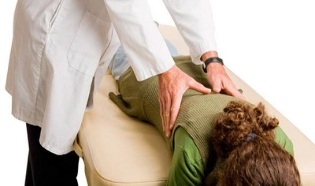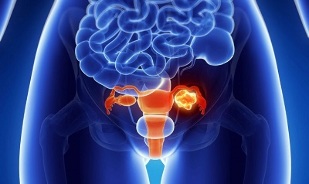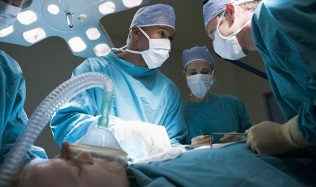
What is lumbar spine osteochondrosis? How is lumbar osteochondrosis treated? And is it true that osteochondrosis is not treated at all? Taking into account the morbidity statistics, the number of cases does not decrease every year. Intervertebral osteochondrosis affects both young people and older people. The method of treatment of osteochondrosis of the lumbar spine and the main symptoms of lumbar osteochondrosis will be described in detail by a neuropathologist or osteopath.
Osteochondrosis is a fairly common disease. Malaise refers to a change in the shape of the vertebrae and a decrease in the elasticity of the intervertebral discs due to cell malnutrition. The lumbar spine suffers for a reason. Located in the lower part of the spine, the vertebrae take the maximum load. When lifting weights, all the force acting on the body is overloaded by depleting the intervertebral space, which leads to compression of the nerve roots. From here, signs of lumbar osteochondrosis begin to appear.
Reasons
Every disease has predisposing factors that negatively affect the body. Osteochondrosis of the lumbar spine also has its causes. Doctors do not rule out the cause, the transmission of the disease at the genetic level. It is believed that if parents have problems with malnutrition of the intervertebral discs, then there is a high probability that this problem will not bypass the children. One of the most popular reasons is hard physical work. When lifting weights, most of the load goes to the lumbosacral spine.
Obesity is an equally common cause of the disease. Excess weight that accumulates in the body puts pressure on the spine and causes pain. It seems that poor posture will not lead to anything serious, but it is also one of the reasons for the wear of the intervertebral discs, which turns into osteochondrosis. Back injuries are important. Corrosion, lifting heavy objects by a poorly trained athlete, or an incorrectly adjusted load also have a negative impact.
The most common cause that interferes with the nutrition of disc cells is a sedentary lifestyle.
In order to keep the body healthy, a person needs a moderate load. Limited or completely absent physical activity leads to a decrease in the speed of blood circulation. As a result, the back muscles, not receiving the necessary nutrients, are weak, and the load on the lumbar spine increases. Also, with age the spine does not become as mobile as in youth, the elasticity of the intervertebral discs decreases, leading to disease.
Infectious diseases or inflammations that affect the bones or joints lead to changes in the structure of the spine. Congenital skeletal malformations or abnormalities in the development of the musculoskeletal system. Flat feet lead to the destruction of segments of the spine due to the lack of shock absorption in the limbs. Most of the load does not fall on the legs, but on the lower back, which leads to deformation of the segments. Stressful situations are a common cause of various diseases. Therefore, lumbar osteochondrosis and its symptoms are no exception. Strong nerve shock can serve as a stimulus to constrict nerve endings and cause an attack of pain. More often stress is the cause of osteochondrosis in women, they are more prone to emotions than men.
Symptoms
The initial stage of the disease is rarely diagnosed by doctors. Therefore, it is difficult to recognize the primary symptoms of osteochondrosis of the lumbar spine. Manifestation of the disease occurs gradually. Since the main manifestation is pain in the lower back, there is a division of pain into 3 groups, which in turn characterize the symptoms and signs of osteochondrosis of the lumbar spine.
- Lumbago- paroxysmal pain that occurs in response to sudden movement or lifting weights. When you try to take a different position, the pain becomes even stronger, all the way to the lumbago.
- Lumbodynia- pain increases and becomes regular. Muscle fibers and intervertebral cartilage are affected. Lumbodynia is a consequence of lumbago.
- Lumboischalgia- painful sensations, cold or heat in the lumbar region and lower extremities. They occur in response to constriction of the spinal cord roots.
The second most important symptom in diagnosing the disease is the restriction of physical activity due to painful sensations. When trying to do work or exercise normally for oneself, a person feels intensified pain, which can affect the whole leg. Even while sitting, the patient feels tingling from the lower back to the feet.
Equally important is a local decrease in temperature and a change in skin color, it becomes dry and pale. Numbness, weakness of the muscles of the lower extremities indicates the progression of the disease. The most severe phenomenon, which is manifested in the last degree of osteochondrosis of the lumbar spine, is dysfunction of the pelvic organs. Constant debilitating pain is accompanied by incontinence of feces and urine, or, conversely, a delay in excretion.
When diagnosing the disease, there are four stages of osteochondrosis of the lumbosacral spine. Each phase is characterized by symptoms of osteochondrosis of the lumbar spine, to which are added low back pain.

In the process of disease progression, osteochondrosis can descend to the final spine, the tailbone. The disease is called sacral spine osteochondrosis. Acute, paroxysmal pain occurs in the buttock area.
In this case, women suffer the most. Their anatomical body structure and age-related changes in it contribute to the development of intervertebral osteochondrosis. Osteochondrosis in women is often complicated by other internal diseases.
The symptoms of lumbosacral osteochondrosis are somewhat different from osteochondrosis of the lower back. Symptoms are manifested in dysfunction of the pelvic organs, which makes it difficult to choose the right treatment and diagnose the cause of the disease. Signs such as frequent urination, urinary and fecal incontinence appear. If the diagnosis is incorrect, complications arise.
Stages of the disease
The treatment of lumbar osteochondrosis also differs from the stage of the disease.
- The first, which is the initial stageof the disease, is characterized by the manifestation of pain in the lower back - lumbago, muscle spasms, local swelling of the skin.
- The second phase,begins with lumbodinia. The pain becomes regular and more intense than in the initial stage. Unusual mobility may appear in the joints of the spine, which increases the feeling of pain. Pain is felt along the sciatic nerve. Rarely, the functions of internal organs may be impaired.
- The third stageis characterized by the appearance of intervertebral hernias. The spine is deformed, the curvature can be left or right, this is scoliosis, forward - lordosis, back - kyphosis. As a result, the person suffers from constant sharp pain.
- Fourth stage,the most difficult. Due to the constant severe pain, the patient's movement is difficult. Without starting treatment on time, a person can be permanently disabled.
Complications
The most common complication is dysfunction of the genitourinary system. Along with incontinence, urine and feces, inflammation occurs in the genitals and rectum. With a more pronounced vertebral lesion, there is irritation in the direction of the sciatic nerve and its inflammation. Intervertebral disc protrusion is a very dangerous complication. Protrusion is a borderline condition of the intervertebral disc, which can lead to the next complication if treatment is not started on time. It occurs due to a transient degenerative change in the spine.
The protrusion results in a herniated disc. Which is manifested by a change in shape and rupture of the membrane of the intervertebral disc.
Constant compression of the nerve roots of the spinal cord and inflammation leads to such complications as radiculitis.
Complete spinal canal obstruction may occur. Due to the instability in the lumbosacral region, men develop congestion in the small pelvis, which leads to impotence. This in women leads to inflammatory diseases of the uterus, ovaries and appendages. On the kidney side, this is renal colic that cannot be eliminated until lower back osteochondrosis is treated. Lower extremity paralysis, which can limit a person to a wheelchair. Timely diagnosis and timely treatment of lumbar spine osteochondrosis help prevent these complications and avoid disability.
Treatment
Let's examine lumbar osteochondrosis, symptoms and treatment. In modern times, medicine is able to achieve the recovery of a person suffering from osteochondrosis. Treatment of osteochondrosis of the lumbosacral spine takes a long time. A sick person who has intervertebral osteochondrosis for the first time will still wonder if it is possible to cure osteochondrosis and how to get rid of it forever?
What to do? Is osteochondrosis of the lower spine treated? You must first completely revise your lifestyle. Draw certain conclusions. You need to go to the desired goal of healing every day without interruption. In osteochondrosis of the lumbar spine, complex treatment of the disease is of great importance. Treatment of lumbosacral osteochondrosis involves several methods.
Conservative
Conservative treatment is based on massage techniques which, if performed correctly, can alleviate muscle spasms and improve muscle fiber nutrition. By improving trophism, the corset of the back muscles is strengthened. Posture takes the correct position, which determines the appearance of various problems with the spine. Physical therapy for lumbar osteochondrosis is very useful, but you need to exercise in the period of remission, between exacerbations. By dealing with the acute period of the disease, you can only make the situation worse and harm your health.
Manual therapy also refers to conservative treatment. It would be performed by an expert specially trained in this technique. Thanks to this therapy, the spine can return to the desired position. This is sometimes the most effective method. Such a procedure should be performed in the subacute period.
Eating, obese people, leading a healthy lifestyle and following a healthy diet will not hurt anyone. And people with such a disease will only benefit. Being overweight is one of the reasons for the appearance of osteochondrosis. Physical therapy is an equally effective treatment. Magnetotherapy, UHF are able to improve blood circulation in the affected area of lumbar osteochondrosis with long-term treatment. They also have a vasodilating and analgesic effect.
Medicinal type of treatment. How to treat osteochondrosis of the lumbar spine with drugs? What should be the treatment, all these questions are of great interest to the sick person. The treatment is divided into two types. In the first case, during the acute period of intervertebral osteochondrosis, the drugs aim to eliminate pain and inflammation. Means are used that release the tightened roots of the spinal nerves. These include muscle relaxants, glucocorticosteroids, blockade, NSAIDs. In the second period, between exacerbations, the funds are used to improve blood circulation, renew muscle and nerve fibers, and damage body tissues. Vitamins and preparations of plant and animal origin are used for this purpose.
Vascular preparations are used to improve blood circulation, as well as ointments for warming and anesthesia.
Operational

Neurosurgeons perform microsurgical and endoscopic operations on the spine.
These methods are more common and are removed when other treatments fail. When the effect of drug therapy is not achieved and complications such as hernia occur, surgery to remove the affected disc is indicated.
Disease Prevention
Prevention of osteochondrosis of the lumbar spine is the exclusion of risk factors that lead to this disease. In order not to think about how to cure lumbar osteochondrosis, you need to prevent its occurrence. Removing the cause is the main preventive measure.
Normalized physical activity, strengthening the back muscles, preventing the maximum load on the lumbar spine, preventing the development of diseases that lead to osteochondrosis, are all preventive measures to prevent the symptoms of lumbosacral osteochondrosis. By following these simple principles, you maintain your health and prolong your life. Finally, without observing treatment and prevention, you may never return to full life



































